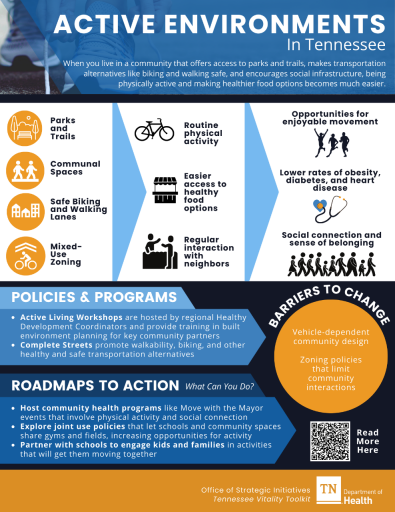Active Environments
Where you live and grow up has such a powerful impact on your health that some say your zip code is a greater determinant of your health and lifespan than your genetic code. Communities are the settings where we live our daily lives and how they are physically designed – often referred to as the built environment - plays a big role in issues like obesity, mental health, and how active we are.
For example, obesity is often seen as a personal health problem, usually blamed on eating too much and not moving enough. The usual solutions are diet and exercise. But the rising rates of obesity show that bigger issues are involved. If communities and neighborhoods are designed to make it easier for people to live healthy, active lives, residents may be able to better address the underlying causes of health issues like obesity.
Active Environments are places that naturally encourage physical activity, like parks, walking trails, and bike lanes. Social Infrastructure includes the places and services that bring people together, like schools, libraries, and community centers. Designing the built environment to include these spaces is important because they make it easier for people to connect and support each other – which is vital for community health.
Creating active environments that combine accessible physical spaces with strong social infrastructure can encourage us all to make healthier choices and be more active. This is a key step in tackling issues like obesity or mental well-being and making our communities healthier for everyone.
In Tennessee, access to active environments and social infrastructure is critical to shaping community health and well-being. According to the Think Tennessee State of Our State report, the growing prevalence of obesity, diabetes and heart disease in Tennessee should cause concern.
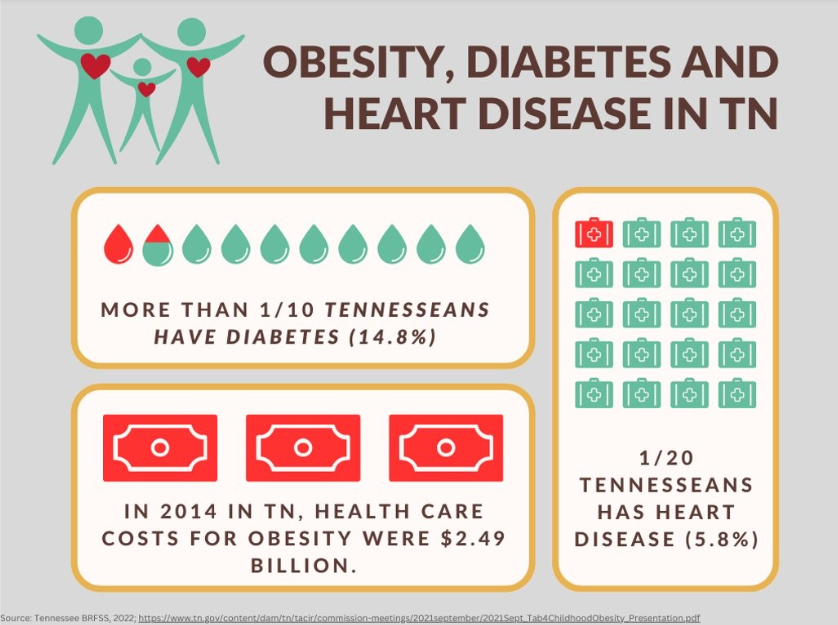
Finally, America’s Health Rankings ranks Tennessee 41st in the nation for risk of social isolation among older adults, highlighting a great need for greater access to social opportunities.
Here's how addressing the built environment as a Social Driver of Health might improve these statistics:
Active Environments Promote Physical Activity: Active environments are places designed to get people moving. Think of parks, walking trails, bike lanes, and even sidewalks. These spaces make it easier for everyone to incorporate physical activity into their daily lives. When people are active, they're less likely to deal with health issues like obesity, diabetes, and heart disease.
Social Infrastructure Builds Strong Communities: Social infrastructure refers to public places that bring people together. This can be anything from schools and libraries to community centers. These places offer more than just services; they provide spaces where people can interact, support each other, and build a sense of belonging. This is crucial for mental health and overall well-being.
Safety and Accessibility: Good active environments and social infrastructure are also safe and easy to access. Safe, well-lit paths and low-traffic streets encourage people to walk, bike, or take public transport. This boosts physical activity levels while also making people feel more connected to their community.
Better Food Choices: Well-designed communities often have better access to healthy food options like grocery stores and farmers' markets. This contrasts with neighborhoods with limited options, where fast food or convenience stores might be the only choices.
Combined Benefits: When active environments are paired with strong social infrastructure, the benefits multiply. For example, a park (active environment) near a community center (social infrastructure) can host group exercise classes, farmers' markets, or community events. This not only promotes physical activity but also offers a social space for community interaction, enhancing both physical and mental well-being.
Unfortunately, many people in Tennessee live in neighborhoods that lack access to opportunities to walk or bike, access to healthy food options, or safe spaces to socialize. This leads to health disparities in certain populations.
Rural Communities
Rural communities frequently experience disparities in access to active environments, as they often have fewer recreational facilities and face geographic challenges that can limit opportunities for physical activity.
Food Insecure Communities
Food insecurity occurs when households have limited or uncertain access to nutritious foods because of money, transportation, or other resource constraints. Tennessee is one of 12 states with a food insecurity rate higher than the national average by a statistically significant amount for all households (TN 16.9% vs United States 13.4%). Lacking constant access to food has been consistently associated with poor health outcomes such as, obesity, diabetes, and premature mortality.
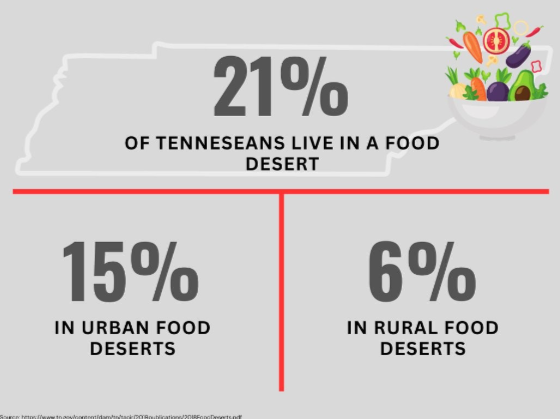
Racial and Ethnic Minorities
Black or African Americans have significantly higher prevalence of diabetes that Whites or Hispanics.
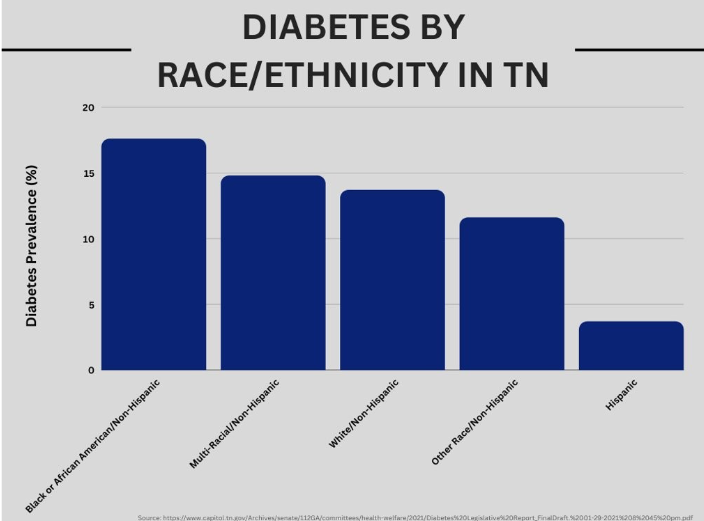
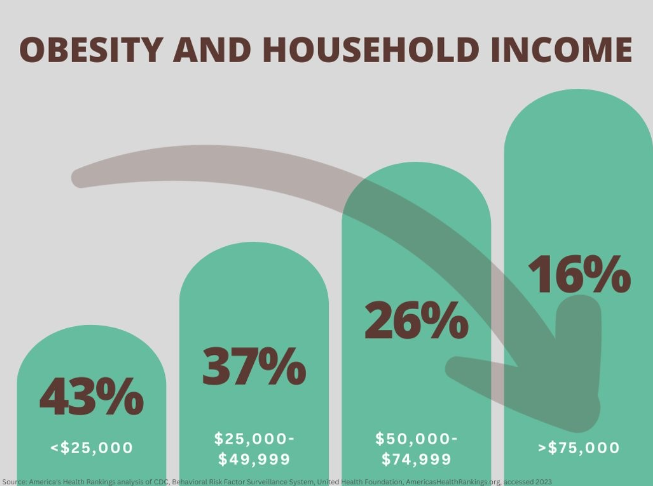
Low-Income Communities
Low-income communities often face significant disparities when it comes to access to active environments, with limited resources and infrastructure for recreational spaces and physical fitness opportunities.
Individuals with Disabilities
Children and adults with mobility limitations and intellectual or learning disabilities are at greatest risk for obesity. People with disabilities find it more difficult to always eat healthy, control their weight, and be physically active.
Activities and Programs: Evidence-informed, actionable, short-term steps that collaborative groups can take to address priority areas.
Policy and Systems Change: Systems change refers to how organizations or programs — such as school systems or health systems — are connected and work together to improve conditions to make change that lasts. This section contains evidence-informed, actionable, long-term steps that collaborative groups can take to address priority areas.
- Ask the Healthy Development Coordinator in your region to conduct an Active Living Workshop for your Health Council and community leaders. These workshops include a crash course on Active Living, a walk audit, and discussion of opportunities to improve on the built environment in your community.
- Host community health programs that incorporate both physical activities and social connection. This might include combining interactive exercise groups with healthy cooking classes or planning a Move with the Mayor.
- Partner with schools to engage kids and their families in activities that will get them moving together, such as school fun runs, walk/bike to school day, or after school programs focused on movement, dance, or connecting with nature.
- Host neighborhood and community cleanups, activities that get people moving and working together towards a common goal of community improvement. Earth Day is a great opportunity to promote this activity. Nobody Trashes Tennessee is a resource from TDOT to support your cleanup.
- Leverage or revamp existing communal spaces by hosting events at a public library, town squares, or public parks. These spaces are a great way to combine physical activity with another healthy activity, such as walking a storybook trail, promoting fine arts through puppet shows, dance, or celebrating beautification projects like art installations.
- Build and regularly convene activities at community gardens to promote healthy eating and community interaction.
- Partner with your county’s ThreeStar program to align community development goals with health priorities from the Community Health Assessment and increase impact across efforts.
- Leverage funding specifically aimed at improving the built environment. This can include initiatives that promote walking and other forms of active living. For funding options, visit the Office of Primary Prevention's Built Environment Funding Opportunities page.
- Advocate for design and zoning policies that focus on walkability, connectivity, and active transportation. Consider specific needs based on population density and vulnerability.
- Promote development of a Complete Streets Plan, particularly for denser areas, emphasize streets designed for all modes of transport.
- Support mixed-use development that allows residential and commercial spaces to coexist, encouraging walking, reducing vehicle dependence, and increasing opportunity for social gathering.
- Explore joint use policies that enable schools and other community spaces to share facilities like gyms and fields, increasing opportunities for physical activity.
- Consider a holistic approach to addressing obesity that treats it as a systemic issue rather than a personal one.
- Involve parents in school-based health initiatives for greater impact, especially in disadvantaged districts.
McMinn Health Council Move with the Mayor:
The McMinn County Health Council is an organized, active health council with over 20 regular community partners as members. In 2022, the health council added “Move with the Mayor” and a community walking trail as Active Living goals in their CHA/CHIP. “Move with the Mayor” is a national program that works with mayors across the country to encourage physical activity in their communities. The program is free for participating communities and supports communities with marketing materials and plans to implement a community activity challenge in collaboration with the Mayor. The city of Athens community implemented “Move with the Mayor” in 2022 and challenged participants to log walking miles all summer. Over 220 participants logged over 6,600 walking miles!
Also during this time, the Health Council, Health Department, and City of Athens collaborated to create a community walking trail spanning 5.6 miles from Athens to a neighboring town. While the community was originally skeptical about the walking trail, it has been a huge success. Community members flock to the trail and rave about how it has helped their community to be healthier. The health council and health department also partnered to write "Pedestrian Billboards" displaying health tips along the route.
Because of the success of these initiatives, the health council is invited to provide a quarterly “Health of the County” report and presentation at the County Commission and City Council meetings. These reports have helped the county government to be more actively engaged with the health council to continue strides that would improve health. The county mayor attends health council meetings and tries to never miss a meeting. The partnership between the McMinn health council and the city on this topic has led to collaboration that improves the opportunities for health in the McMinn community.
Tennessee Department of Health
- The Office of Primary Prevention helps Tennessee communities build a culture of health through livable and nurturing places and spaces so that everyone can reach their full potential. The office has several resources on the built environment including a newsletter and Healthy Built Environment Grants.
- Healthy Development Coordinators (HDCs) engage in cross-sector collaboration to address the social and environmental determinants of health. Each HDC lives and works in one of the state’s seven health regions, developing relationships and collaborating with a wide range of local stakeholders to prioritize health in decisions related to land use planning, transportation, housing, greenspace, food access, and economic development.
- The Healthy Places website has many resources dedicated to the connection between place and health.
- Project Diabetes funds primary prevention projects that aim to prevent disease from ever occurring. Such prevention is implemented through the utilization of policy, systems, and environmental changes (PSE) within the communities of Tennessee.
Tennessee Department of Economic and Community Development
- ThreeStar is a strategic community development program developed to assist communities in preparing for a better future. The ThreeStar program now incorporates asset-based planning initiatives and a two-year timeline to accomplish goals. The asset-based planning component helps communities develop goals to maximize their local assets to drive economic development. Starting in 2019, biennial grants will be available to counties to align with one of the community’s identified goals.
Tennessee Department of Education
- Tennessee Coordinated School Health connects physical, emotional and social health with education through eight inter-related components. This coordinated approach improves students' health and their capacity to learn through the support of families, communities and schools working together. Coordinated School Health works with many partners to address school health priorities.
Tennessee Department of Transportation
- The Tennessee Department of Transportation (TDOT) plans, develops, funds, builds, repairs and manages our statewide transportation network. TDOT’s influence reaches into highways, public transportation, bike and pedestrian, aeronautics, waterways, rail and freight. TDOT’s Office of Community Transportation partners with local agencies to improve collaboration on transportation decisions.
- At Nobody Trashes Tennessee, community action is the cornerstone of environmental stewardship. Programs to support communities include No Trash November, Adopt-A-Highway, Litter Hotline, Litter Grants, and Keep Tennessee Beautiful.
Governor’s Early Literacy Foundation
- Storybook Trails are a partnership with Tennessee State Parks Conservancy, city parks and outdoor areas to create enriching outdoor reading experiences for children and families to connect literacy with a fun, physical activity. This program presents a children’s storybook on child-height panels along a short trail to promote adult-child interaction around books and nature.
U.S. Surgeon General
- The National Strategy to Advance Social Connection includes recommendations to strengthen social infrastructure in local communities.
National Association of Chronic Disease Directors
- Building Resilient Inclusive Communities is working with states to address food and nutrition security, improve safe physical activity access, and reduce social isolation and loneliness through a policy, systems, and environmental change lens.
Centers for Disease Control and Prevention (CDC)
- The CDC’s Active People Healthy Nation website lists strategies and tools to help communities plan for Active Environments.
Community Preventive Services Task Force (CPSTF)
- Recommendations from CPSTF include park, trail, and greenway infrastructure interventions when combined with additional interventions to increase physical activity.
